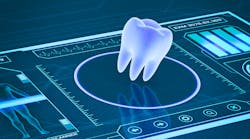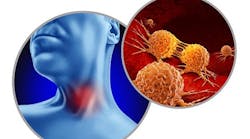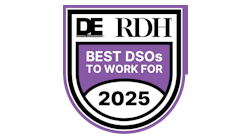Editor’s note: This is part one of a series. Read part two here.
Every patient deserves quality care regardless of their insurance status. As dental hygienists, we have taken an oath to “render a full measure of service to each patient entrusted to our care.” This oath is not contingent on the patient’s age, race, insurance status, or even the time allotted for the dental hygiene appointment.
Quality care can be defined as characteristics of service beyond technical competence that shape the patient care experience and clinical care. Quality dental hygiene services advance the delivery of dental hygiene care, improve communication between the patient and provider, and increase oral health literacy. Utilizing technology is adjunctive to quality care, but it can also aid in patient engagement, improve case acceptance, and increase insurance approval.
How technology became a necessity in dentistry
Chronic disease management and care coordination: Expanding the dental provider's role
Several technologies are available for dental hygiene that advance the understanding of the oral-systemic link, educate patients, and allow them to make the best decisions for the delivery of their care. When we level up our services in dental hygiene, the patients we serve are healthier.
Technologies for hygiene workflows
Artificial intelligence (AI) is not a new concept when we consider using smartphones, social media, digital streaming, internet services, and electric cars. In dentistry, we have had a small glimpse of AI in the past with devices such as the periscope, intraoral cameras, and cloud-based practice management software. The opportunities for AI to be integrated into the dental hygiene workflow are many.
Considering calibration of radiographs and treatment philosophies, Pearl and Overjet are leaders in AI. Both technologies can compare radiographs over time and accurately assess bone levels, incipient lesions, calculus deposits, and densities within the oral anatomy. This calibration is a huge step forward for dentistry and improves the relationship with insurance payers, boosts case acceptance, and promotes oral health literacy. Each dental provider can review the recommendations the AI software makes and then offer a professional opinion on the patient’s treatment. While the AI software is subjective, the clinician can provide an objective assessment and use the software as a foundation for evidence-based decision-making.
Introducing patients to our assessments lets them know that we individualize their care. Not every patient is healthy, so a prophy may not be warranted for every patient on your schedule every day. Periodontal charting offers an overview of the patient’s periodontal health and helps us determine the level of overall health.
Voice-activated periodontal charting is a game changer when it comes to educating patients and getting them involved in the diagnosis pathway. Once we have thoroughly assessed the patient’s periodontal condition and they understand that optimal oral health includes the absence of bleeding, our assessments can serve as a basis for patient engagement and education. When the patient is fully engaged and has a baseline understanding of how we arrived at our diagnosis, their case acceptance will improve, and behavior will be modified.
Intraoral photography not only provides visual data in a way the patient understands, but it also opens the door to teledentistry and autonomous dental hygiene practice. By using intraoral photography, we can share improvements in the oral condition, areas of concern, and anatomy that may need to be monitored. This technology is a clear and convenient time stamp of the patient’s current oral status and is easy to incorporate into the dental hygiene workflow.
Digital scanning is a great opportunity to engage patients with details on their oral health. Digital scans create a 3D model that can be compared over time and identify even the slightest change in oral structures. It also gives the patient an in-depth look at their occlusal patterns. Records can be compared to identify any changes that have occurred. This technology can help patients envision how their smiles will look after proper tooth alignment. Even the most seasoned professional may have a difficult time integrating digital scans into their workflow, but once they do, it’s a game changer and hard to live without. Digital scanning is a great way to show patients the causal factors that may have long-term detrimental effects on their mouth using the 3D model, and thus empower them to make decisions.
All these technologies can be stored in most dental practice management software programs, and assessments can be printed out for the patient to review or emailed for the tech-savvy consumers.
How can technology help dental hygiene practice?
Learning and improving
Revisiting the dental hygiene oath that we took at the inception of our professional journey, we said that we would continuously improve the science and art of dental hygiene. Newsflash: technology is advancing the art and science of dental hygiene. We pledged to be lifelong learners, and that includes learning new technologies. Integrating technology that is designed for patient education is advancing the science of dental hygiene and requires a renewed mindset to learn the intricacies of the hardware/software.
Quality
Most patients have a difficult time recalling their dental treatment. If your patients are anything like mine, when we use suction, they often ask, “Is that new?” With technology, the dental appointment becomes an immersive experience for the patient, and it’s hard for them to forget it. Quality care includes communication. Communication is a by-product of integrating technology. It’s not enough to integrate technology; one must explain how it is integral to enhanced assessments.
Accuracy and efficiency
Calibrating team members from different backgrounds and who may hold different beliefs can sometimes prove to be a challenge. The use of technology has an advantage in helping a diverse set of minds visualize treatment through the same lens. Technology is subjective and doesn’t discriminate on details. The level of detail technology affords aids in making a fair and accurate assessment with a diagnosis that is consistent among providers.
Integrating technology improves the efficiency of the hygiene appointment and streamlines the discussion on oral health. Having a systematic workflow that includes technology increases productivity and adds value to the hygiene department.
Effective communication
Technology encourages communication. Effective communication results in educated patients. Educated patients make informed decisions. Gone are the days when we offered patients a printed brochure; most people read on a digital device today, and they expect most of their reading materials to be presented in the same way.
Insurance approval
With detailed assessments, payers have little room to deny claims. Technology creates a calibrated opportunity for each viewer to visualize the areas of concern. When the evidence is clear and there is digital documentation, it’s difficult for a payer to deny a claim. Even when a claim is denied, the patient now understands the treatment recommendation. When the patient is ready to move forward with treatment, they will dispute the claim with insurance payers and opt to pay for the service themselves.
Editor’s note: Stay tuned for the next edition of RDH when Alicia Murria will cover more on the topic of technology.
This article appeared in the January/February 2023 print edition of RDH magazine. Dental hygienists in North America are eligible for a complimentary print subscription. Sign up here.






